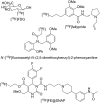Flow microreactor synthesis in organo-fluorine chemistry
- PMID: 24367443
- PMCID: PMC3869211
- DOI: 10.3762/bjoc.9.314
Flow microreactor synthesis in organo-fluorine chemistry
Abstract
Organo-fluorine compounds are the substances of considerable interest in various industrial fields due to their unique physical and chemical properties. Despite increased demand in wide fields of science, synthesis of fluoro-organic compounds is still often faced with problems such as the difficulties in handling of fluorinating reagents and in controlling of chemical reactions. Recently, flow microreactor synthesis has emerged as a new methodology for producing chemical substances with high efficiency. This review outlines the successful examples of synthesis and reactions of fluorine-containing molecules by the use of flow microreactor systems to overcome long-standing problems in fluorine chemistry.
Keywords: defluorination; flow microreactor; fluorination; fluorine; organo-fluorine; perfluoroalkylation.
Figures














Similar articles
-
Recent Advances in Fluorination Reactions via De-Carboxylative and De-Oxygenative Strategies: A Perspective.Chem Rec. 2025 Apr 24:e202500068. doi: 10.1002/tcr.202500068. Online ahead of print. Chem Rec. 2025. PMID: 40270212 Review.
-
Establishing Cation and Radical Donor Ability Scales of Electrophilic F, CF3, and SCF3 Transfer Reagents.Acc Chem Res. 2020 Jan 21;53(1):182-197. doi: 10.1021/acs.accounts.9b00393. Epub 2019 Dec 11. Acc Chem Res. 2020. PMID: 31823601
-
The organometallic fluorine chemistry of palladium and rhodium: studies toward aromatic fluorination.Acc Chem Res. 2010 Jan 19;43(1):160-71. doi: 10.1021/ar9001763. Acc Chem Res. 2010. PMID: 19788304 Review.
-
A machine learning approach for predicting the fluorination strength of electrophilic fluorinating reagents.Phys Chem Chem Phys. 2022 Nov 9;24(43):26802-26812. doi: 10.1039/d2cp03281c. Phys Chem Chem Phys. 2022. PMID: 36314580
-
Development of N-F fluorinating agents and their fluorinations: Historical perspective.Beilstein J Org Chem. 2021 Jul 27;17:1752-1813. doi: 10.3762/bjoc.17.123. eCollection 2021. Beilstein J Org Chem. 2021. PMID: 34386101 Free PMC article. Review.
Cited by
-
One Amine-3 Tasks: Reductive Coupling of Imines with Olefins in Batch and Flow.Chemistry. 2020 Jan 27;26(6):1363-1367. doi: 10.1002/chem.201904483. Epub 2020 Jan 21. Chemistry. 2020. PMID: 31777987 Free PMC article.
-
Gas/Liquid-Phase Micro-Flow Trifluoromethylation using Fluoroform: Trifluoromethylation of Aldehydes, Ketones, Chalcones, and N-Sulfinylimines.ChemistryOpen. 2019 Feb 5;8(4):406-410. doi: 10.1002/open.201800286. eCollection 2019 Apr. ChemistryOpen. 2019. PMID: 30976483 Free PMC article.
-
Investigation of Inlet Conditions in The Mixing Process of Nanoparticles and Blood in a T-Shaped Microfluidic Reactor with Small Rectangular Cavities.Yale J Biol Med. 2023 Mar 31;96(1):43-55. doi: 10.59249/FUAH2942. eCollection 2023 Mar. Yale J Biol Med. 2023. PMID: 37009188 Free PMC article.
-
Multifaceted Ion Exchange Resin-Supported Hydrogen Fluoride: A Path to Flow Hydrofluorination.Green Chem. 2019 May 7;21(9):2224-2228. doi: 10.1039/C8GC03166E. Epub 2018 Dec 26. Green Chem. 2019. PMID: 31402845 Free PMC article. No abstract available.
-
Decarboxylative fluorination strategies for accessing medicinally- relevant products.Curr Top Med Chem. 2014;14(7):966-78. doi: 10.2174/1568026614666140202210850. Curr Top Med Chem. 2014. PMID: 24484421 Free PMC article. Review.
References
-
- Banks R E, Smart B E, Tatlow J C. Organofluorine Chemistry: Principles and Commercial Applications. New York: Plenum Press; 2000.
-
- Hiyama T, Kanie K, Kusumoto T, et al. Organofluorine Compounds: Chemistry and Application. Berlin: Springer-Verlag; 2000. - DOI
-
- Kirsch P. Modern Fluoroorganic Chemistry. Weinheim: Wiley-VCH; 2004. - DOI
-
- Chambers R D. Fluorine in Organic Chemistry. Oxford: Blackwell; 2004. - DOI
-
- Uneyama K. Organofluorine Chemistry. Oxford: Blackwell; 2006. - DOI
Publication types
LinkOut - more resources
Full Text Sources
Other Literature Sources
